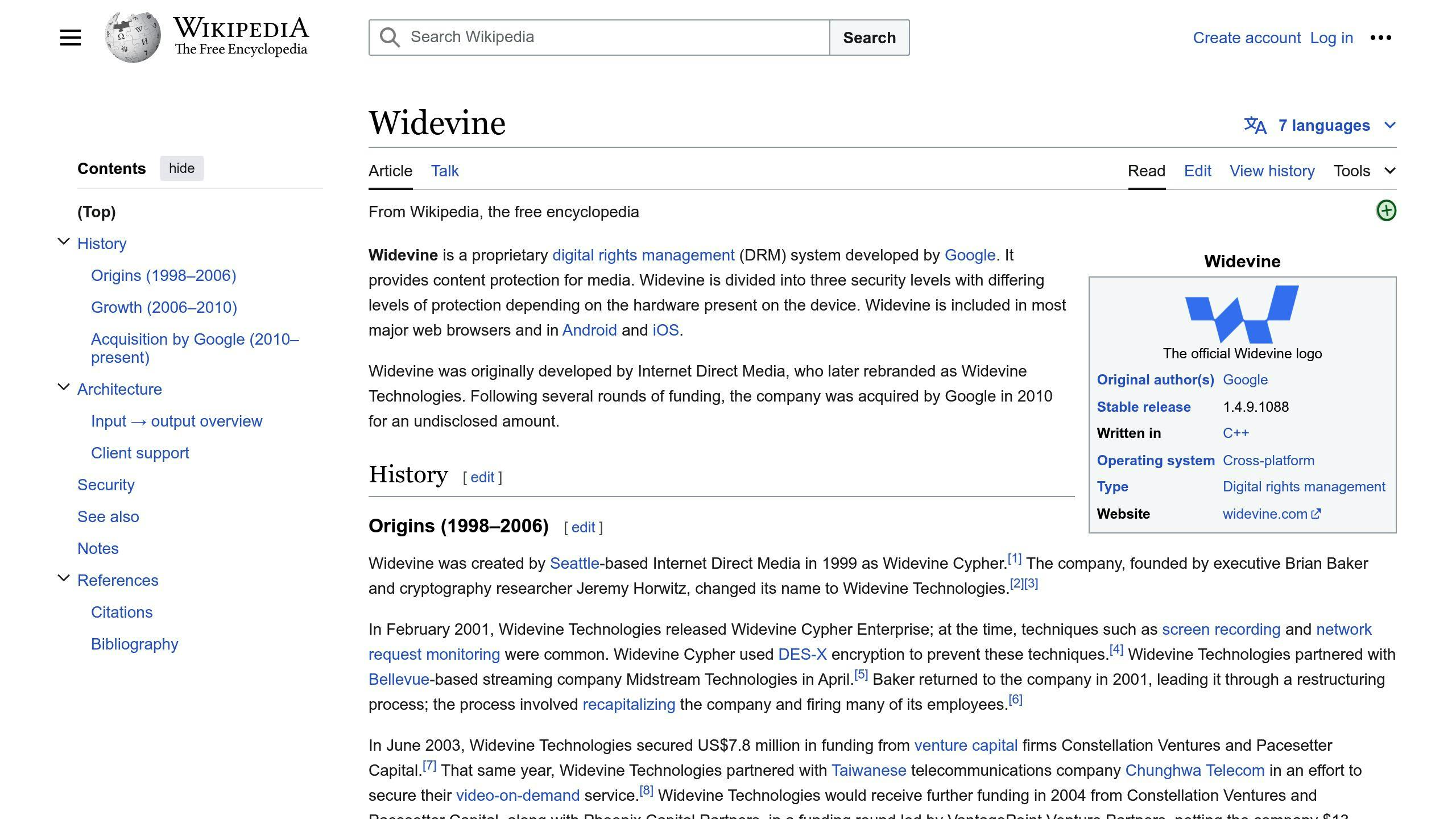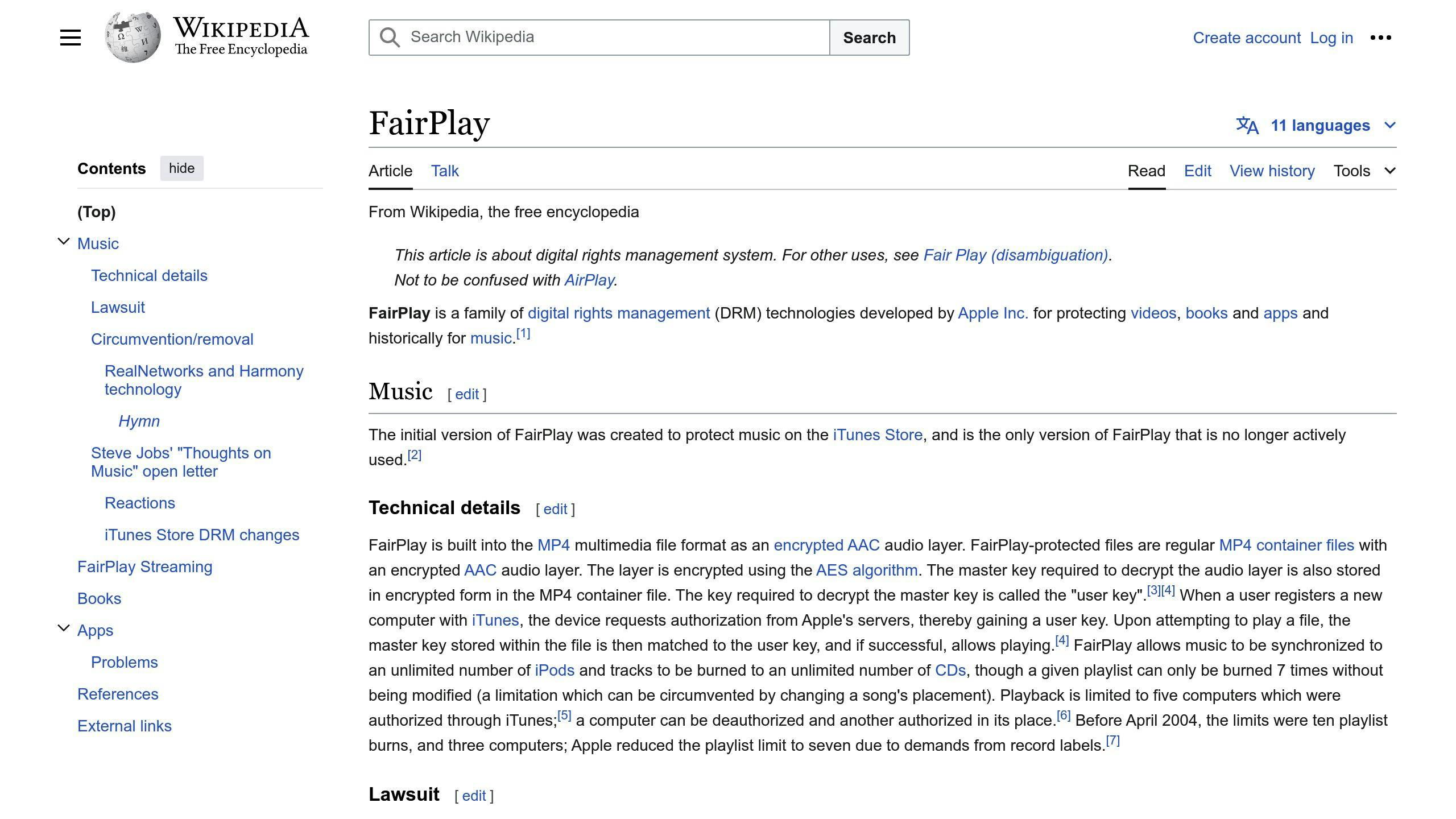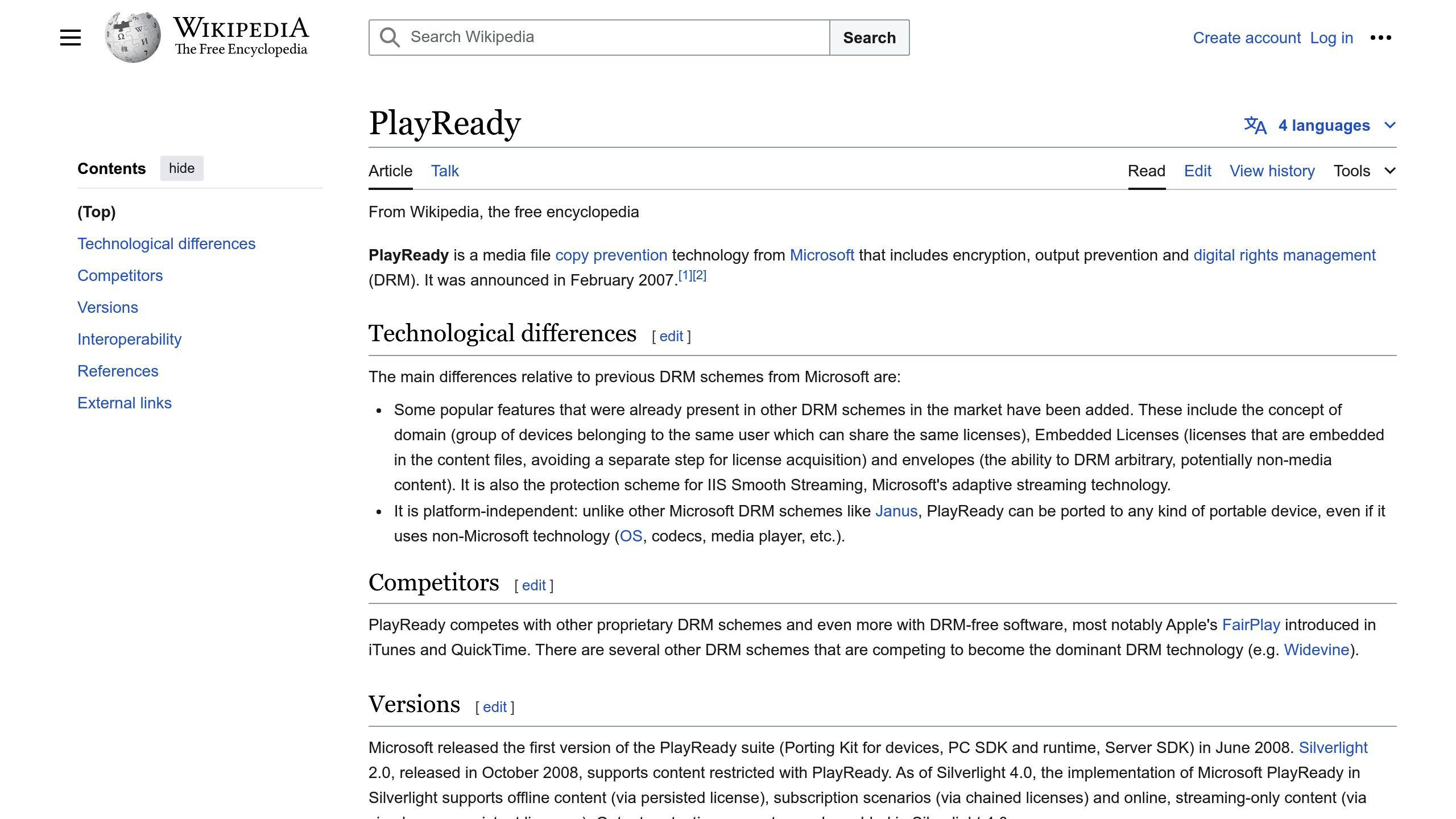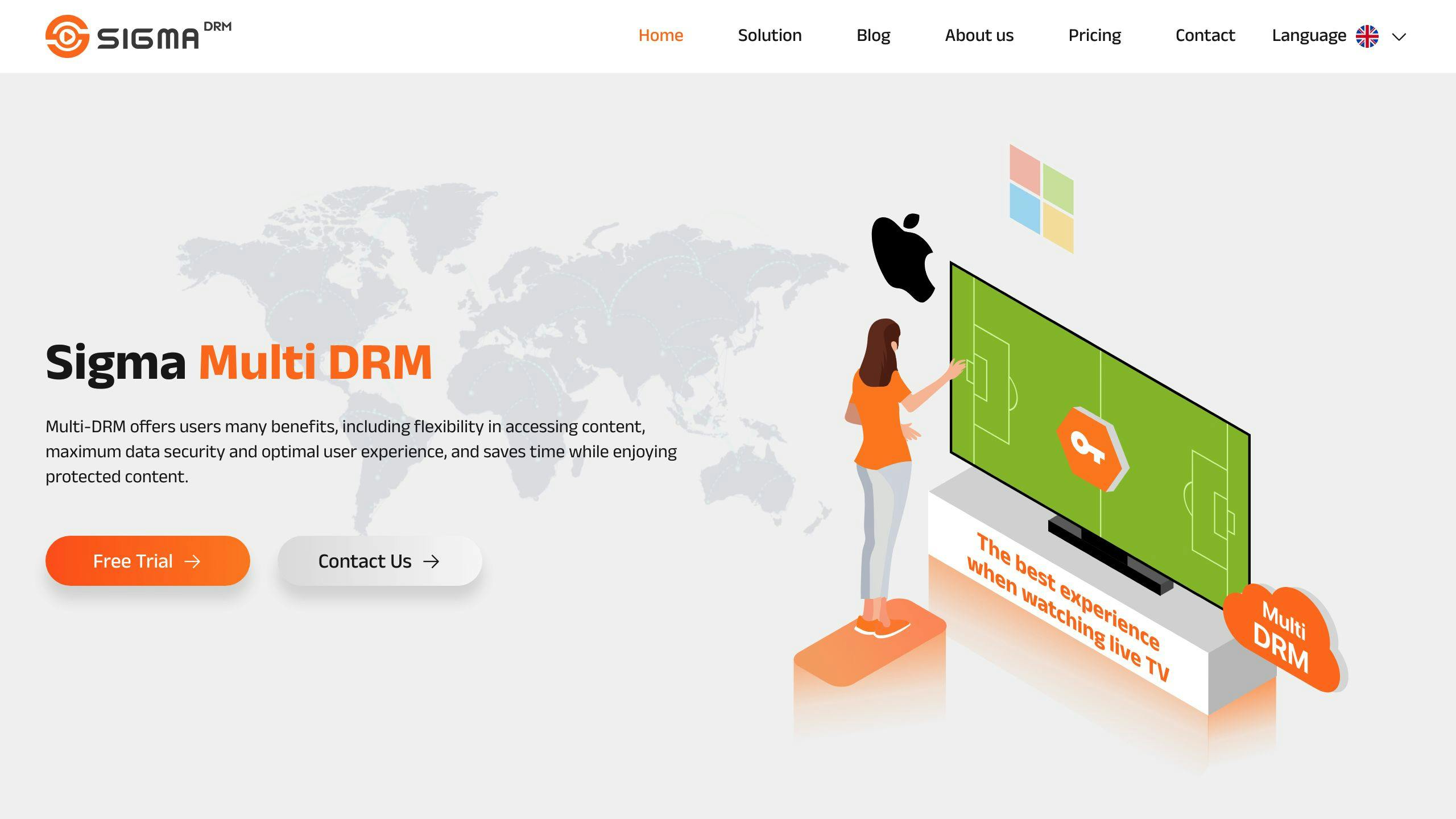Digital Rights Management (DRM) is a technology that protects digital content like videos, music, e-books, and software from unauthorized access and piracy. This guide covers the essentials of implementing a robust cross-platform DRM strategy to secure and monetize your digital content across various devices and platforms.
Related video from YouTube
Key Benefits of DRM
| Benefit | Description |
|---|---|
| Copyright Protection | Prevents unauthorized copying and distribution |
| Revenue Generation | Enables monetization by controlling access |
| Secure Distribution | Allows safe distribution across platforms |
| Usage Tracking | Monitors how content is being used |
Understanding Cross-Platform DRM
As users access content on multiple devices (smartphones, tablets, TVs), a cross-platform DRM solution ensures seamless and secure access regardless of platform. This provides a consistent user experience while protecting your content.
Implementing Cross-Platform DRM
- Choose the right DRM technologies (e.g., Widevine, FairPlay, PlayReady)
- Integrate the technologies into your content delivery system
- Set up license management for authorized access
- Consider compatibility, scalability, ease of use, and security
Popular DRM Technologies
| Technology | Compatible Platforms | Key Features |
|---|---|---|
| Google Widevine | Android, Chrome, Edge, Firefox, Roku, Smart TVs | Content protection, smooth streaming |
| Apple FairPlay | iOS, macOS, Safari, AppleTV | Strong encryption, secure license management |
| Microsoft PlayReady | Windows, Android, iOS | Robust content protection, advanced license management |
| Sigma DRM | Multi-platform | High security standards, efficient license management |
Multi-DRM Solutions
Multi-DRM solutions like Axinom DRM, Intertrust ExpressPlay, and Verimatrix Multi-DRM provide a unified approach to managing multiple DRM technologies, simplifying content protection across platforms.
Forensic Watermarking
Combining forensic watermarking with DRM provides an extra layer of security by embedding invisible identifiers in content, allowing you to trace the source of unauthorized distribution and take legal action against piracy.
The Future of DRM
The future of DRM will focus on user privacy, AI-powered content protection, platform compatibility, and cloud-based solutions for scalability and flexibility.
By implementing a strong cross-platform DRM strategy, you can effectively protect and monetize your digital content while providing a seamless user experience across devices and platforms.
sbb-itb-738ac1e
Understanding DRM
What is DRM and Why is it Used?
Digital Rights Management (DRM) is a technology that protects digital content like videos, music, e-books, and software from unauthorized use, copying, and sharing. It allows content creators and distributors to control how their digital works are accessed and used, preventing piracy and theft of intellectual property.
In today’s digital world, DRM plays a vital role in safeguarding content across various platforms and devices. With the rise of online streaming and digital distribution, DRM has become essential for content owners to monetize their works while preventing unauthorized access.
How DRM Works
DRM systems typically involve three main components:
- Encryption: Digital content is encrypted, making it unreadable without a valid decryption key.
- Access Control: DRM systems manage access to the decryption keys, granting access only to authorized users or devices.
- Usage Rules: DRM enforces rules on how the content can be used, such as limiting the number of devices or preventing copying.
These components work together to provide a secure and controlled environment for digital content distribution.
The History of DRM
The concept of DRM dates back to the 1960s when the first encryption methods were developed to protect digital information. However, it wasn’t until the 1990s that DRM technologies gained traction, particularly with the rise of online music distribution. Since then, DRM has evolved to address new threats and user demands, with various industries adopting DRM technologies to protect their digital assets.
Key Benefits of DRM
| Benefit | Description |
|---|---|
| Copyright Protection | DRM helps prevent unauthorized copying and distribution of digital content. |
| Revenue Generation | By controlling access, DRM enables content creators to monetize their works effectively. |
| Secure Distribution | DRM allows for secure distribution across various platforms and devices. |
| Usage Tracking | Content owners can track and monitor how their works are being used. |
While DRM has faced criticism for potentially limiting fair use and user rights, it remains an important tool for content creators to protect their intellectual property in the digital age.
Why Cross-Platform DRM Matters
Multiple Devices and Platforms
Today, people access digital content on various devices like smartphones, tablets, smart TVs, and gaming consoles. Each device has unique requirements and limitations. A cross-platform DRM solution must work seamlessly across all these devices to protect content and ensure authorized access.
Need for Consistent User Experience
Users expect to access their digital content without interruption, regardless of the device or platform. A unified DRM approach provides a smooth experience, reducing frustration and building trust. A consistent DRM experience is crucial for user satisfaction.
Cross-Platform DRM Challenges
| Challenge | Description |
|---|---|
| Compatibility | Ensuring the DRM solution works with different devices and platforms. |
| Evolving Content | Staying ahead of piracy threats as digital content evolves. |
| Balancing Security and Convenience | Providing secure content access without compromising user experience. |
By understanding these challenges, content creators and distributors can develop effective strategies to implement cross-platform DRM solutions.
Implementing Cross-Platform DRM
Key Considerations
- Encryption Standards: Adopt industry-standard encryption methods to protect content across platforms.
- Device Support: Ensure the DRM solution supports various devices, operating systems, and platforms.
- User Authentication: Implement secure user authentication methods for authorized access.
- Usage Rules: Define clear rules for content usage, such as limiting device count or preventing copying.
Benefits of Cross-Platform DRM
| Benefit | Description |
|---|---|
| Content Protection | Prevents unauthorized access, copying, and distribution of digital content. |
| Revenue Generation | Enables content monetization by controlling access across platforms. |
| Wider Reach | Allows secure distribution to a broader audience using different devices. |
| Usage Tracking | Monitors how content is being used across platforms. |
Popular DRM Technologies
Google Widevine

Google Widevine is a widely used DRM technology that works on many devices. It protects content and provides a smooth streaming experience. Widevine is compatible with Android, Chrome, Edge, Firefox, Roku, Smart TVs, and more.
Apple FairPlay

Apple FairPlay is a DRM technology designed for Apple devices. It uses strong encryption to protect content. FairPlay works with iOS, macOS, Safari Browser, and AppleTV, offering a secure way to access digital content.
Microsoft PlayReady

Microsoft PlayReady is a popular DRM technology that protects various media formats like audio, video, and eBooks. It offers robust content protection and license management. PlayReady is used in the entertainment industry and works with Windows, Android, and iOS.
Sigma DRM

Sigma DRM is a comprehensive solution for protecting video-on-demand and over-the-top streaming services. It works on multiple platforms, has high security standards, and is efficient and scalable. Sigma DRM is a good choice for content owners and distributors who need a reliable DRM solution.
Comparing DRM Technologies
| DRM Technology | Compatible Platforms | Security Features | License Management |
|---|---|---|---|
| Google Widevine | Android, Chrome, Edge, Firefox, Roku, Smart TVs | Content protection, smooth streaming | Robust license management |
| Apple FairPlay | iOS, macOS, Safari, AppleTV | Strong encryption standards | Secure license management |
| Microsoft PlayReady | Windows, Android, iOS | Robust content protection | Advanced license management |
| Sigma DRM | Multi-platform | High security standards | Efficient, scalable license management |
This table compares the key features of each DRM technology, helping content owners and distributors choose the right DRM solution for their needs.
Implementing Cross-Platform DRM
Putting a cross-platform DRM strategy in place involves several key steps. Choosing the right DRM technologies, integrating them into your content delivery system, and considering factors like compatibility, scalability, and ease of use are crucial for success.
Choosing DRM Technologies
When selecting a DRM technology, think about your target audience and how you’ll distribute your content. For example, if your content is mainly consumed on Android devices, Google Widevine may be a good choice. If your content is mostly accessed on Apple devices, Apple FairPlay may be more suitable. Evaluate the strengths and weaknesses of each DRM technology and choose the ones that best fit your needs.
Integration Process
Integrating multiple DRM technologies into your content delivery system requires careful planning and execution. Here are the general steps:
- Content Preparation: Encrypt your content with the chosen DRM technologies.
- DRM Technology Integration: Integrate the DRM technologies into your content delivery system, such as your video player or streaming platform.
- License Management: Set up a system to manage and distribute licenses to users.
- Content Protection: Protect your content with the integrated DRM technologies.
Key Considerations
When implementing a cross-platform DRM strategy, consider these key factors:
- Compatibility: Ensure the chosen DRM technologies work with your target devices and platforms.
- Scalability: Choose DRM technologies that can grow with your content library and user base.
- Ease of Use: Select DRM technologies with easy-to-use APIs and minimal setup complexity.
- Security: Evaluate the security features of each DRM technology and choose the ones that provide strong content protection.
Cross-Platform DRM Comparison
| DRM Technology | Compatibility | Scalability | Ease of Use | Security |
|---|---|---|---|---|
| Google Widevine | Android, Chrome, Edge, Firefox, Roku, Smart TVs | High | Moderate | Strong |
| Apple FairPlay | iOS, macOS, Safari, AppleTV | Moderate | Easy | Strong |
| Microsoft PlayReady | Windows, Android, iOS | High | Moderate | Strong |
| Sigma DRM | Multi-platform | High | Easy | High |
This table compares key considerations for cross-platform DRM implementation, helping content owners and distributors choose a DRM technology.
Multi-DRM Solutions: Simplifying Content Protection
Multi-DRM solutions offer a unified approach to managing multiple DRM technologies. This simplifies protecting digital content across platforms and devices. Let’s explore the advantages of multi-DRM solutions and popular options.
Benefits of Multi-DRM
Multi-DRM solutions provide several key benefits:
- Streamlined content protection: Protect content across platforms and devices using a single system.
- Wider reach: Support multiple DRM technologies to reach a broader audience.
- Seamless user experience: Eliminate compatibility issues for a smooth viewing experience.
- Enhanced security: An additional layer of security makes it harder to bypass content protection.
Popular Options
Several multi-DRM solutions are available, including:
- Axinom DRM: Cloud-based, supports Widevine, PlayReady, and FairPlay.
- Intertrust ExpressPlay: Supports a wide range of DRM technologies like Widevine, PlayReady, and FairPlay.
- Verimatrix Multi-DRM: Supports Widevine, PlayReady, FairPlay, and more.
Comparing Multi-DRM Solutions
| Solution | Supported DRM Technologies | Cloud-Based | Scalability |
|---|---|---|---|
| Axinom DRM | Widevine, PlayReady, FairPlay | Yes | High |
| Intertrust ExpressPlay | Widevine, PlayReady, FairPlay, and more | No | High |
| Verimatrix Multi-DRM | Widevine, PlayReady, FairPlay, and more | Yes | High |
This table compares popular multi-DRM solutions, highlighting their supported DRM technologies, cloud-based capabilities, and scalability.
Forensic Watermarking: Tracing Digital Content Piracy
Forensic watermarking is a powerful tool to combat digital piracy. It involves embedding a unique, invisible identifier into digital content like videos. This identifier helps trace the source of unauthorized distribution, allowing content owners to take legal action against pirates and protect their intellectual property.
What is Forensic Watermarking?
Forensic watermarking is a type of digital watermarking designed to be undetectable and resistant to removal or alteration. It is typically used alongside Digital Rights Management (DRM) technologies to provide an extra layer of security and traceability. Forensic watermarks can be embedded into various digital content types, including videos, images, and audio files.
Combining Watermarking and DRM
Forensic watermarking can be effectively combined with DRM solutions to provide comprehensive content protection. By embedding a forensic watermark into digital content, content owners and distributors can identify the source of unauthorized distribution, even if the content is decrypted or stripped of its DRM protection. This allows for real-time defensive measures, such as shutting down pirate streams or identifying and prosecuting individuals involved in piracy.
Benefits of Watermarking
Forensic watermarking offers several benefits:
- Deterrent effect: Pirates know their illegal activities can be traced back to them.
- Real-time tracking: Enables swift action against pirated content.
- Identifying vulnerabilities: Helps improve content distribution to prevent future piracy.
Overall, forensic watermarking is a powerful tool against digital piracy, and its combination with DRM solutions provides robust content protection.
| Benefit | Description |
|---|---|
| Deterrent | Pirates know their activities can be traced |
| Real-time tracking | Enables swift action against pirated content |
| Vulnerability identification | Helps improve distribution to prevent piracy |
Future of DRM
User Privacy
As people become more concerned about privacy, DRM solutions will need to balance protecting digital content with respecting user rights. This may involve:
- Transparent and user-friendly privacy policies
- Giving users control over how their data is collected and used
AI in DRM
Artificial intelligence (AI) will play a big role in the future of DRM, enabling:
- More advanced content protection
- Improved efficiency of DRM systems
AI-powered DRM can analyze user behavior and detect security threats in real-time, allowing for better protection of digital content.
Platform Compatibility
DRM solutions will need to work with a wide range of devices and platforms. This will:
- Allow users to access content seamlessly across different devices
- Enable content creators and distributors to reach a wider audience
Cloud-Based DRM
The shift towards cloud-based DRM services is expected to continue, driven by the need for:
| Benefit | Description |
|---|---|
| Scalability | Cloud-based DRM can handle growing content libraries and user bases |
| Flexibility | Users can access content from anywhere, on any device |
| Cost-Effectiveness | More efficient and cost-effective content management and protection |
Overall, the future of DRM will focus on providing effective content protection while respecting user privacy and enabling compatibility across platforms.
Conclusion
Implementing a strong cross-platform DRM strategy is crucial for protecting and monetizing digital content today. As the digital content industry evolves, staying updated on the latest DRM technologies and best practices is essential.
By understanding cross-platform compatibility, choosing the right DRM technology, and implementing a multi-DRM solution, content creators and distributors can ensure their digital content is protected and accessible across various devices and platforms.
A successful DRM strategy requires balancing content protection with user experience. By respecting user privacy, utilizing AI-powered DRM, and ensuring platform interoperability, you can create a secure and seamless content consumption experience for your audience.
Stay ahead by embracing the latest advancements in DRM technologies and adapting to the changing needs of the digital content industry.
Key Takeaways
- Implement a robust cross-platform DRM strategy to protect and monetize digital content.
- Choose the right DRM technology based on your target audience and distribution channels.
- Consider a multi-DRM solution for streamlined content protection across platforms.
- Balance content protection with user privacy and a smooth experience.
- Leverage AI and ensure platform compatibility for effective DRM implementation.
- Adapt to the evolving digital content landscape and stay updated on DRM advancements.
| Benefit | Description |
|---|---|
| Content Protection | Prevent unauthorized access, copying, and distribution. |
| Monetization | Control access to enable revenue generation. |
| Wider Reach | Secure distribution across devices and platforms. |
| User Experience | Provide a seamless content consumption experience. |
| Future-Proofing | Stay ahead with the latest DRM technologies and best practices. |

